This is part 2 in a series of posts based on PSP’s talk with Union head coach Jim Curtin. Find part 1 here.
Jim Curtin played defense. He believes in defense. So while he certainly won’t complain when the Union score goals, he thinks sustained success begins in the back.
“Interesting stat, and it’s an obvious stat when you hear it: In games where teams kept a clean sheet last year, they averaged 2.5 points,” Curtin told PSP. “That’s common sense. You don’t give up a goal, more likely to win. The only other thing that can happen is a 0-0 draw.
“In games where you give up a goal, the average is 1.2 points. The focus has to be not conceding first. We’re going to score, other teams are going to score, but, simply put, keeping a zero is the easiest way to get points at the end of the day. It’s an obvious one, but it’s one that jumps out at you.”
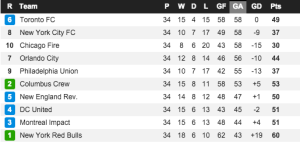
2015 Eastern Conference table sorted by Goals Against.
The table agrees. Of the six MLS teams that gave up 50 goals or more, only two made the playoffs. And those two teams tucked away their defensive frailty behind the league’s top goalscorers.
So while Curtin could point to nine clean sheets as a sign that the Union are on the cusp of turning a porous defense into a strength, he can also look at ten games in which his team gave up three or more goals and conclude that change is needed.
As the Union’s offseason moves indicate, the club is taking the latter viewpoint.
“The first step is getting guys that can run so there’s more consistency. Otherwise it drives me insane, I know it drives the fans insane,” Curtin said. “It’s difficult when you see a team that gets to back to back [US] Open Cup finals and shows they can compete with any team in the league, and they can look awful in the regular season and look like we don’t belong in the playoffs. Consistency is the word I keep coming back to.”
Consistency also describes Philly’s success in the SuperDraft, but not in a good way. Amobi Okugo and Jack McInerney both briefly ascended into the starting eleven only to quickly disappear from the roster altogether. Michael Farfan looked dangerous out wide, but a move inside stunted his growth. Zac MacMath was the only draft pick to get an extended run in the first team at the position he was drafted to play before Curtin declared Ray Gaddis the starting right back last year.
But this offseason, the Union are rebuilding the defense through the SuperDraft. Andre Blake will start in goal, Ray Gaddis and Keegan Rosenberry will compete on the right, Richie Marquez and Josh Yaro will see plenty of time in the center, and Taylor Washington should push for minutes on the left as the season progresses. At times, the Union could have a number one overall, number two overall, and number three overall SuperDraft pick all starting together in back.
All of those players, and, according to the club, the yet-unseen Anderson Conceicao, share a few qualities: They’re young, they’re affordable, and they are absurdly athletic.
“Yaro certainly can run, there’s no secret there,” Curtin said. “So he’ll have the confidence to get into foot races and not be scared of that. Richie Marquez is also a guy that can run. And if he does get pulled out into those wide spots, his 1v1 defending is excellent.
“I think with [Anderson] Conceicao, an athlete who can find himself in space and not be nervous, it’s a big one.”
In talking to Curtin, it is fairly clear that the Union are attempting to address 2015’s defensive struggles with two adjustments: First, high-end (really high-end) athleticism is a minimum requirement for defenders. Second, defensive discipline must start up top. Those adjustments can sound fairly independent, but they are different battles in what famed soccer tactician George Lucas might have called Star Space Wars.
Successful soccer can be boiled down to two simple rules, both involving space: Create it on offense and take it away on defense. That’s it!
Taking away space is the real motivation behind the modern high press game. Pundits and coaches may talk about pressing better or more effectively, but what they really mean is finding ways to minimize the amount of space opposing players have when they get the ball and when they move without it. And those two things cannot be traded off: Taking away time on the ball but leaving giant swaths of green behind is as ineffective as taking away all the passing lanes but letting the ball carriers waltz into the box unopposed.
In soccer, space can be thought of as a useful proxy for accumulated time. On an individual level, space and time are synonymous. But from a team-level perspective, minimizing time on the ball can be interpreted as: Attack the ball carrier! Whereas controlling space requires a defense to no longer view the opposition as a group of trees, but as a forest. Otherwise eliminating space for one player will almost certainly open space for another. Result: Zero net gain in space, and possibly a loss of it.
Let’s take an example that has played out many times for the Union. Philly loses the ball and the other team plays it wide to an outside back. Philly’s wing player sprints to the ball, minimizing the fullback’s time to think. Pressing? Yes. Eliminating time? Absolutely. But what about space? Now the Union’s wide player has left a gigantic hole between him and his supporting outside back. The opposing team can play the ball into that space, recycle it across the back, or find a central midfielder five yards ahead, which pulls another Union player into the mix, makes the team lopsided, and creates so many holes that the Union defense starts to look like a physical manifestation of Sepp Blatter’s corruption depositions.
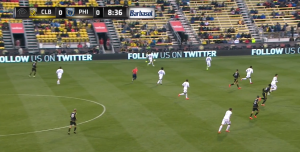
Early in the April 25 loss to Columbus, the Union’s defensive lines were tight, forcing Columbus wide without allowing endless time for crosses.
In the memorable implosion of April 2015 against Columbus, the Crew continually exploited Philadelphia’s inability to control space. Crosses were unchallenged, the passes leading to those crosses were unchallenged, and the defense was so concerned with keeping Kei Kamara away from goal that it let him operate in between the lines and pull in midfielders. Tony Tchani and Federico Higuain had all the time they needed to spread the ball around and further pull the Union apart.
But it did not start out that way. For the first fifteen minutes of the match, the Union held a fairly tight shape. However, that structure soon broke down as a lack of pressure up front gave Michael Parkhurst plenty of time to spray the ball to the wings. Gaddis and Fabinho were slow to close down the ball and crosses to Kamara quickly turned into goals.
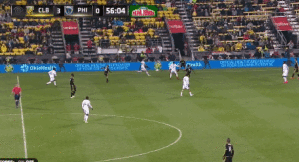
Click to play.
When on-the-ball pressure was not the main issue, the Union simply did not work hard enough to get back into shape when they lost it. In the 57th minute, Maidana got caught leaning forward during a Columbus throw in (see gif). Michael Lahoud stepped hard to press Higuain and, without Maidana covering, left the entire center of the pitch open for a dangerous transition.
In the 60th minute, Sebastien Le Toux closes space high up the pitch instead of retreating to the midfield. Columbus easily turned that error into a breakout by playing the ball into the space left behind by the Union’s winger.
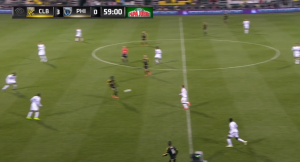
Le Toux stays high instead of dropping into a line with the midfield.
These examples do a lot to explain why the Union were willing to trade away Cristian Maidana’s fifteen assists, and they speak to macro issues with defensive spacing. But Earnie Stewart and Jim Curtin spent a lot of SuperDraft capital on the defense because controlling space involves smart pressing up front and compression in back.
“We found ourselves getting so stretched from our front line to our back line,” Curtin said. “Sixty yards at times, and that’s… I don’t care how many athletes on the field are good or bad athletes, you’re going to get picked apart by a team that can pass.
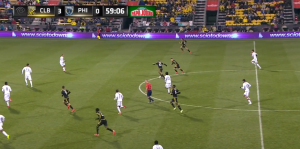
Columbus plays the ball central then easily transitions wide to break forward in numbers with Le Toux left chasing. (2 of 2)
“When that number shrinks to 30-35 yards front to back, I don’t care where you are on the field, whether you’re high up pressing in their half, whether you’re pinned in at the top of the 18 and it’s only 30 yards, you’re going to be a hell of a lot harder to break down.”
And the Union are capable of such organization. They had it against
Columbus in April before they collectively forgot to play defense. They had it against New England in October before dropping too deep and letting the Revolution fire a 21st birthday’s worth of shots at Andre Blake.
Dropping too deep was a troll that refused to let Philly cross the bridge to relevance last season. Early in the year, Ethan White’s low confidence led him to weird positions deep behind his fullback that continually invited service into the corner.
White may have been unafraid of 1v1s, but he struggled to win them. Later in the season, the Union back line dealt with a
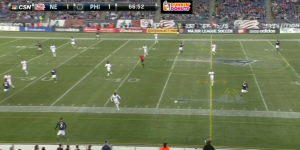
Union defense compressing space well: All players within 20 yards. When Tierney collects the ball he will be under pressure from Ayuk, Lahoud will cut off a central pass, and the only option will be to play back where a striker should be ready to pin the ball to the touchline.
different issue as it became clear that Steven Vitoria was extremely timid in wide areas.
“He’s a good defender,” Curtin said, “But his skill set called for us to drop our line. He did not like to get isolated. That makes everyone change by 4-5 yards, which is a big deal in our league.”
Vitoria’s cautious nature is clearly evident on tape. Against New England late in the season, he continually pulled the Union line deep and invited pressure as Philly could not cover all the space in the middle when the Revs moved the ball with any speed. And as the team tired of chasing, that 30 yard shape that Jim Curtin wants to see began to stretch.
The Union drafted fast, technical defenders. To remedy last year’s struggles, they will look to play a higher line that compresses the field and forces the opposition to outrun guys like Josh Yaro and Richie Marquez into the corners. Marquez showed last season that he can run with anyone, and Yaro has the same reputation. Better pressure up front is designed for force long, early passes. A high line in back is meant to force strikers to go a long way to track down those passes. And guys who can run are supposed to make tracking down those passes extremely hard.
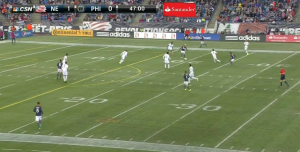
Vitoria holds a man onside for no particular reason.
In short, the Union have a defensive strategy and, unlike last offseason, they are bringing in players with the attributes to execute that strategy.
But that is still only half the battle. Curtin and his staff have to show they can train a back line — and goalie — to move as a unit. Compressing space makes it a lot harder for the opposition to hit throughballs, but leaving spaces between the fullbacks and center backs will allow even a tight defensive shape to get burned.
“We got isolated outside a lot, guys got beat, center backs didn’t slide out quick enough, it wound up being free service, and in our league you get punished for that,” Curtin told PSP. “We have games where you go, ‘This team is all on the same page. They can press, they’re picking balls off, they’re scoring goals.’ And then you have games where you go, ‘What the hell…’”
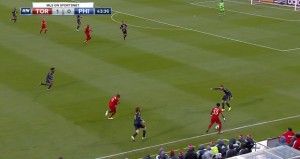
Wenger presses too high, getting tight before his line can shift over. That’s about as much space as you’ll ever see between a fullback and a center back on a pro team.
Teaching a defense how to operate as a unit is one of the key ways that Curtin could be judged as a coach this season. Philadelphia has a young defense with a lot to prove, and how that unit develops will be a firm measure of the Union coaching staff.
Curtin knows this, and when asked how he will approach this task, he says it is about understanding the players as individuals so you can train them to play as a team.

Wenger Island? No support leaves Wenger, who is new to the fullback game, all alone.
““Different guys learn different ways. One thing Earnie’s been very instrumental in is an individual plan for each player. So each player will now have, from the technical, the tactical, the psychological, they will have their own plan. Not just on the field, but also in the video room by themselves or in the back four or the midfield three. So we’ll have a much better grasp of each player’s individual needs. It doesn’t guarantee success, but it sets us up better to have success if everybody is on the same page and understands the commitment it’s going to take. Because if one guy is late, or if one guy is lazy defensively, it leads to trouble.
Curtin believes a focus on individualized preparation can prevent the falling to pieces that characterized the Union’s most demoralizing losses in 2015. “I want everyone to have the mindset that everyone attacks and everyone defends. Hopefully that leads to, right off the bat, a belief that we can come back. Look, you’re going to give up goals. It’s part of the game. But at the same time we need to have a better reaction after we do.
A lot of times when we gave up goals last year, you could see the faces on the field thinking, ‘Oh, this is going to be an uphill battle.’”
As Curtin himself said, every team gives up goals. But in 2016, the Union need to make teams work to score. And that means a defensive strategy that minimizes space, the personnel to execute it, and a coach that can drill the strategy into the heads of a young but talented defense. Philly rode a brilliant defense to the playoffs in 2011. Curtin will be perfectly happy bringing his club back to the postseason the exact same way.
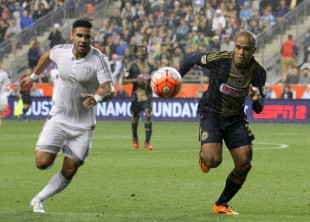

A lot to digest here… good stuff…
.
you know what I want… a suicidally high back line and a team that siphons the air out of the other team’s defensive end and then pinches up to provide serviceable outlet solutions for their midfielders in possession… that’s what I want… technical and intelligent defense that bodes to the philosophy of play… which is organized defensive pressure not this chicken without a head bullshit we have been fed like Castor oil or 5 years.
.
It is unbearable watching how far off the defense has laid over and over again last year and in years prior when in possession and when out of possession.. I detest it.
.
Makes the field too big and makes the game a polonium isotope of breakneck paced decay – – – HATE IT.
.
One of my most important metrics for whether this guy can manage or not.
suicidally high being relative before I incur the wrath of others.
Seems like we are getting the horses in the back to make that happen. Basically daring teams to get into footraces with us.
.
Also seems like we have mainly 2 types of players on the team now. Burners and guys who can run forever.
Not sure I’m okay with this yes foot races are part of the game, but when was the last time anyone on the Union won a foot race. When for that matter was the last time this team out fitnessed any team in the league. I can think of multiple games I was sitting there saying damn they look gassed whose on the bench that we can bring in. Yes Marquez is athletic and a good CB. Yaro I have heard can run down anyone. Gaddis is one of the fastest defenders in the league. Yes this is all good, but the ball always moves faster than the player. Playing a high line is not a bad idea by any stretch just not sure the lineup dictates this working. Can’t forget that our midfielders are no speed demons to get back. And Edu has no positional awareness in the midfield.
I don’t know, most of what Curtin said was about the athleticism. I do think we will push higher than when Vittoria played thank god.
Well Vittoria was a waste of space and guy was slower than a tree. He was never cut out for this league. Just hope Conceicao has more speed.
“…starts to look like a physical manifestation of Sepp Blatter’s corruption depositions.”
.
That line had me laughing. Great article – informative and fun.
this is such a great article. thank you so much for writing it. great analysis and it also makes me feel confident in the defensive plan coming from curtin and stewart
-rant on-
.
Good God what and article!!! Hell, I’m sending it to my dad who is a coach down in FL just for the insight it holds.
.
I’ve said it once and I’ll say it again, PSP needs to allow us to support it. T-Shirts, Patreon, cold hard cash pressed into the hand, something!
.
The quality that continues to spill forth non-stop from this site deserves support…
.
Please guys, let us show you how much we appreciate your work by allowing us to support PSP!
.
-rant-off-
please let us buy t shirts and hoodies
+1. For all the complaining we were doing about how the team is going to look I never thought we would get a series like this. Insight you rarely is ever get in sports. Kudos to Curtin for the interview and to Adam for filling in everything else in such a great way.
Love the coding reference.
.
Yeah, maybe just sell a few goodies at the SOB lot to start…then open up a little store on this page.
.
We have enough readers here…isn’t someone in Marketing? Get on some t-shirt designs! Hell…I’ll take a beer cozy!
CafePress is effectively print-on-demand for coffee mugs, t-shirts, hoodies, and so on. Upload logos, setup what merchandise you want the logo to appear on, and then give the link to your “store” to your customers. They take a pretty good percentage of sales (I really can’t recall how much), but the trade off is you don’t need to maintain inventory and you don’t need to have your own online store.
Wow! Exceptional stuff! AGAIN! Thanks so much for all the work from the entire staff at PSP!! Yes to helping any way we can! And excited to see this team do some playing… Not just hoof it up field to nobody in particular!
I want to echo everyone before me by saying what a great article this is. There are not many places where I can go to actually learn about a game like this. Even Philly.com, which has a lot of good writers for other sports, is nothing like this.
.
I like the philosophy of defensive strength, defense wins championships. I just want and need to to be paired with a cohesive plan going forward.
.
I think everyone is high on Blake and Marquez, and excited about Yaro and Rosenberry as prospective high end talents. I’m just a little bit cautious about being to excited about this year, as we’re still talking about 1st and 2nd year players, along with Gaddis (who had a down year), Fabinho (best year, but we know his limitations) and Anderson (new to the league).
.
I think our best hope for this year is seeing massive potential that shows itself in moments during every game, while allowing for some young mistakes.
Any chance the Union try a 3-5-2?
.
Pontius-Sapong
Barnetta
fabinho-edu-nogueira-gaddis/rosenberry
Anderson-marquez-yaro
Jim Curtin’s earlier comment referring to Edu – as a DCM – coming back between widely spaced center backs to get the ball strongly suggests a four man back line.
.
The variation I expect to see used experimentally is two DCMs but not side by side, rather offset and one higher than the other, with Barnetta at ACM in front of them, but remaining more central to drop in if Nogueira or Edu makes an attacking run..
.
I would call it a tweeked 4-2-3-1
We know that Stewart leans towards a Dutch 4-3-3. Curtin’s comment about having EDU drop in possession is intriguing.
Thinking their goal is to have the fullbacks attack high up the field in possession, w/ the opposite wings coming in. Essentially creates a 3-5-2 in attack. Makes sense with Fabinho. Not so much with Gaddis…could explain a bit more why they’re so high on Rosenberry.
+1. Was thinking the exact same thing.
I think this is a good approach, but unless you can possess the ball for longer periods you cannot defend for 60 minutes or more. We need to possess the ball AND build a counter attack from a strong defense. If the defense stays disciplined and is more athletic (faster) and the attack actually moves the ball with the intent of shooting we should see a vast improvement.
I’ll echo everyone else on how nice it is to get this level of analysis here. But am I the only one who was getting nothing when clicking on the pictures? The one even says “click to play”, which I did for about 5 minutes but nada. Eventually it occurred to me that something might be amiss.
Ditto on what Mikex said. This article is simply stellar. And nothing happened when I clicked on the pix.
Good piece, as per usual. People who miss Maidana, in my opinion, fail to understand the value of shape in this game. It’s very rare a player can float with such freedom as he and be a net positive to the team (certainly no MLSers come to my mind). Fifteen assists is absolutely positive, sure, but not when you tally the number of times he was directly involved in our opposition’s offensive maneuvering.
Higuain fits that description, I’d say. Columbus lets him range basically wherever he wants. I think he clearly is a positive, but it’s worth noting that Columbus succeeds despite a relatively leaky defense, so I think your point stands.
Almost sounds like they didn’t scout or watch any film on Vitoria before they signed him.
It’s almost as if they have no scouts.
good article. Just a few observations. If an attacker looses the ball, A rough rule is you press like hell for 6 seconds to get it back. after that, you drop back into position. If you press as a unit, you press against the sideline. not so much in the open field. The sideline acts as a defender. Midfielders should not hold the ball more than 6 sec. because good teams will see that and press (with tactical fouling thrown in). Watch and see if the team sets up with a 4 vs. 2 type support around the ball. If not, then they are vulnerable to a press. High line and compactness works, but something must be sacrificed and that should be the edges of the field. This makes you vulnerable to crosses , but crosses in to the box are statistically a very inefficient way to score.( unless the ball is worked deep into touch and then crossed back out .To defend compactly, you must have at least 2 lines of 4, with the outside midfielders closing down potential crossers of the ball. Pressing and compact defense has a large statistical component difficult for some traditionalists to accept.Speed is good but must be accompanied by quickness. Intelligence is HUGE and that might be the big flaw with many defender. They are athletic enough but might have difficulties playing within a system. How to attack compact pressing defense is another story.Watch for this stuff when watching the games this weekend. Juventus is terrific with this stuff.Thats why they are always in the running against teams with better personel.
@K – Good points. Curtin talked about pressing in the open field for 5-6 seconds after a turnover, I just haven’t gotten there yet. I think teams still press in the open field, but it’s not the same kind of explicit on-the-ball press. It’s about angle of approach and forcing the ball to the sidelines so that direct pressure can be applied. The two banks of four comes in almost universally once a team has moved the ball into the final third and set up an offense.
Continuous pressing is too exhausting, especially in the Rockies so absolutely one must be selective. Another pressing trigger is if the midfielder is facing his own goal when recieving the ball and tries to turn with it. He must be attacked with the risk of fouling. Why? because more that half the goals scored from run of play are scored by midfield and defensive turnovers. Let me say this. Why is a guy from NYC posting on a Philly blog. Because this is the most literate, intelligent blog I have seen. You guys deserve a better team with better uniforms.
@K – That’s a great point, and one Curtin brought up later. Last season the Union were guilty of playing passes that left guys completely back-to-goal instead of on the half-turn, and that makes a huge difference in terms of getting out of the back and into established possession play.
Hearing the Union are letting Dave Rowan go… seems odd, any insights?
The hoodie you can ride in!